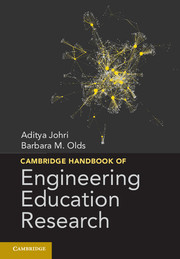Book contents
- Frontmatter
- Dedication
- Contents
- Editors
- Contributors
- Foreword
- Acknowledgments
- Introduction
- Chapter 1 Chronological and Ontological Development of Engineering Education as a Field of Scientific Inquiry
- Part 1 Engineering Thinking and Knowing
- Chapter 2 Learning Theories for Engineering Education Practice
- Chapter 3 Situative Frameworks for Engineering Learning Research
- Chapter 4 The Social Nature of Representational Engineering Knowledge
- Chapter 5 Conceptual Change and Misconceptions in Engineering Education
- Chapter 6 Engineers as Problem Solvers
- Chapter 7 Professional Engineering Work
- Part 2 Engineering Learning Mechanisms and Approaches
- Part 3 Pathways into Diversity and Inclusiveness
- Part 4 Engineering Education and Institutional Practices
- Part 5 Research Methods and Assessment
- Part 6 Cross-Cutting Issues and Perspectives
- Index
- References
Chapter 4 - The Social Nature of Representational Engineering Knowledge
Published online by Cambridge University Press: 05 February 2015
- Frontmatter
- Dedication
- Contents
- Editors
- Contributors
- Foreword
- Acknowledgments
- Introduction
- Chapter 1 Chronological and Ontological Development of Engineering Education as a Field of Scientific Inquiry
- Part 1 Engineering Thinking and Knowing
- Chapter 2 Learning Theories for Engineering Education Practice
- Chapter 3 Situative Frameworks for Engineering Learning Research
- Chapter 4 The Social Nature of Representational Engineering Knowledge
- Chapter 5 Conceptual Change and Misconceptions in Engineering Education
- Chapter 6 Engineers as Problem Solvers
- Chapter 7 Professional Engineering Work
- Part 2 Engineering Learning Mechanisms and Approaches
- Part 3 Pathways into Diversity and Inclusiveness
- Part 4 Engineering Education and Institutional Practices
- Part 5 Research Methods and Assessment
- Part 6 Cross-Cutting Issues and Perspectives
- Index
- References
Summary
What we call “descriptions” are instruments for particular uses/applications. Think of a machine-drawing, a cross-section, an elevation with measures, that an engineer has before him. Thinking of a description as a word-picture of the facts has something misleading about it: One tends to think only of pictures, as they hang on our walls; they appear simply to portray how a thing looks like, what it is like.
(Wittgenstein, 1953/1997, p. 99, my translation)Introduction
The purpose of this chapter is to articulate a perspective on the nature of representation in engineering that has been developed on the basis of ethnographic and sociological studies across science and technology. It is a sociocultural and cultural-historical perspective that has some decided advantages over the “cognitive approach” for the teaching of engineering, an approach that has an exclusive focus on what goes on in the mind and hidden from view. Consistent with the social-psychological diction that all higher cognitive functions are societal relations that come to shape those who participate in them (Vygotsky, 1989), this chapter focuses on the social dimensions of representations because these are the origin of anything that we may attribute to the mind. But because these social dimensions are what we subsequently attribute to mind, the perspective developed here also is a cognitive one. However, rather than speculating about hidden mental processes, this approach allows us to study psychological functions in the very public arena where they originate. We may express this fundamental fact in the following aphorism: engineering representations are in the mind because they are integral to the societal relations engineers entertain. Among those who study representations-in-use, the term “inscription” tends to be employed. Inscriptions include diagrams, photographs, formulas, and tables, that is, anything other than language that features in scientific research and communication. In this chapter, I move from the term representation to inscription, because the latter allows us to eschew the frequent confusion between “internal” and “external” representations. I present some of the advantages for engineering education that come with this way of thinking about representational engineering knowledge.
- Type
- Chapter
- Information
- Cambridge Handbook of Engineering Education Research , pp. 67 - 82Publisher: Cambridge University PressPrint publication year: 2014
References
- 4
- Cited by

